Long-term health and wellbeing of people affected by the 2002 Bali bombing
VerifiedAdded on 2023/03/23
|11
|2784
|22
AI Summary
This article examines the long-term health and wellbeing effects of the 2002 Bali bombing on the affected victims and their subsequent generations. It discusses the physical, mental, and well-being problems faced by the victims and the need for early intervention and support.
Contribute Materials
Your contribution can guide someone’s learning journey. Share your
documents today.
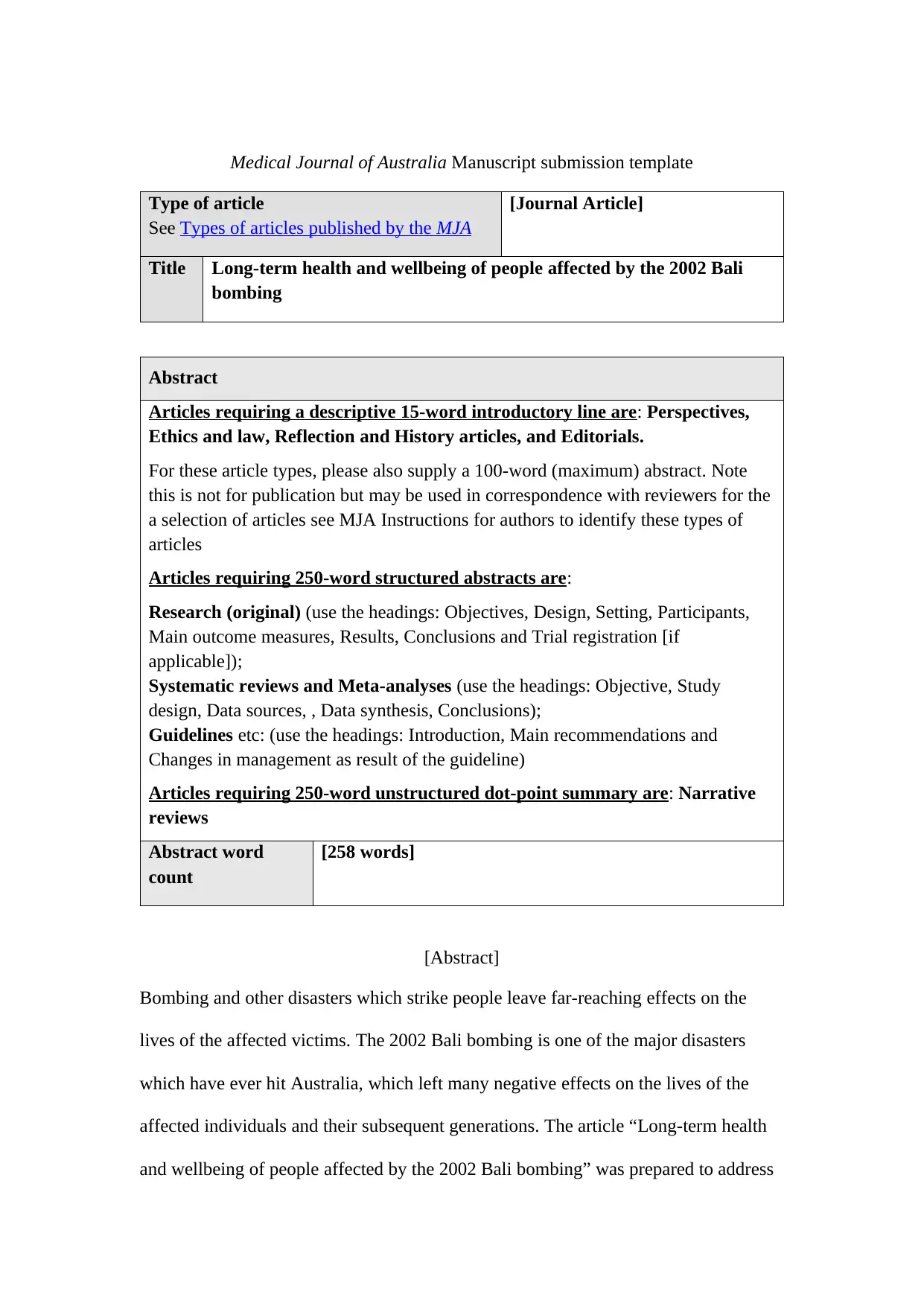
Medical Journal of Australia Manuscript submission template
Type of article
See Types of articles published by the MJA
[Journal Article]
Title Long-term health and wellbeing of people affected by the 2002 Bali
bombing
Abstract
Articles requiring a descriptive 15-word introductory line are: Perspectives,
Ethics and law, Reflection and History articles, and Editorials.
For these article types, please also supply a 100-word (maximum) abstract. Note
this is not for publication but may be used in correspondence with reviewers for the
a selection of articles see MJA Instructions for authors to identify these types of
articles
Articles requiring 250-word structured abstracts are:
Research (original) (use the headings: Objectives, Design, Setting, Participants,
Main outcome measures, Results, Conclusions and Trial registration [if
applicable]);
Systematic reviews and Meta-analyses (use the headings: Objective, Study
design, Data sources, , Data synthesis, Conclusions);
Guidelines etc: (use the headings: Introduction, Main recommendations and
Changes in management as result of the guideline)
Articles requiring 250-word unstructured dot-point summary are: Narrative
reviews
Abstract word
count
[258 words]
[Abstract]
Bombing and other disasters which strike people leave far-reaching effects on the
lives of the affected victims. The 2002 Bali bombing is one of the major disasters
which have ever hit Australia, which left many negative effects on the lives of the
affected individuals and their subsequent generations. The article “Long-term health
and wellbeing of people affected by the 2002 Bali bombing” was prepared to address
Type of article
See Types of articles published by the MJA
[Journal Article]
Title Long-term health and wellbeing of people affected by the 2002 Bali
bombing
Abstract
Articles requiring a descriptive 15-word introductory line are: Perspectives,
Ethics and law, Reflection and History articles, and Editorials.
For these article types, please also supply a 100-word (maximum) abstract. Note
this is not for publication but may be used in correspondence with reviewers for the
a selection of articles see MJA Instructions for authors to identify these types of
articles
Articles requiring 250-word structured abstracts are:
Research (original) (use the headings: Objectives, Design, Setting, Participants,
Main outcome measures, Results, Conclusions and Trial registration [if
applicable]);
Systematic reviews and Meta-analyses (use the headings: Objective, Study
design, Data sources, , Data synthesis, Conclusions);
Guidelines etc: (use the headings: Introduction, Main recommendations and
Changes in management as result of the guideline)
Articles requiring 250-word unstructured dot-point summary are: Narrative
reviews
Abstract word
count
[258 words]
[Abstract]
Bombing and other disasters which strike people leave far-reaching effects on the
lives of the affected victims. The 2002 Bali bombing is one of the major disasters
which have ever hit Australia, which left many negative effects on the lives of the
affected individuals and their subsequent generations. The article “Long-term health
and wellbeing of people affected by the 2002 Bali bombing” was prepared to address
Secure Best Marks with AI Grader
Need help grading? Try our AI Grader for instant feedback on your assignments.
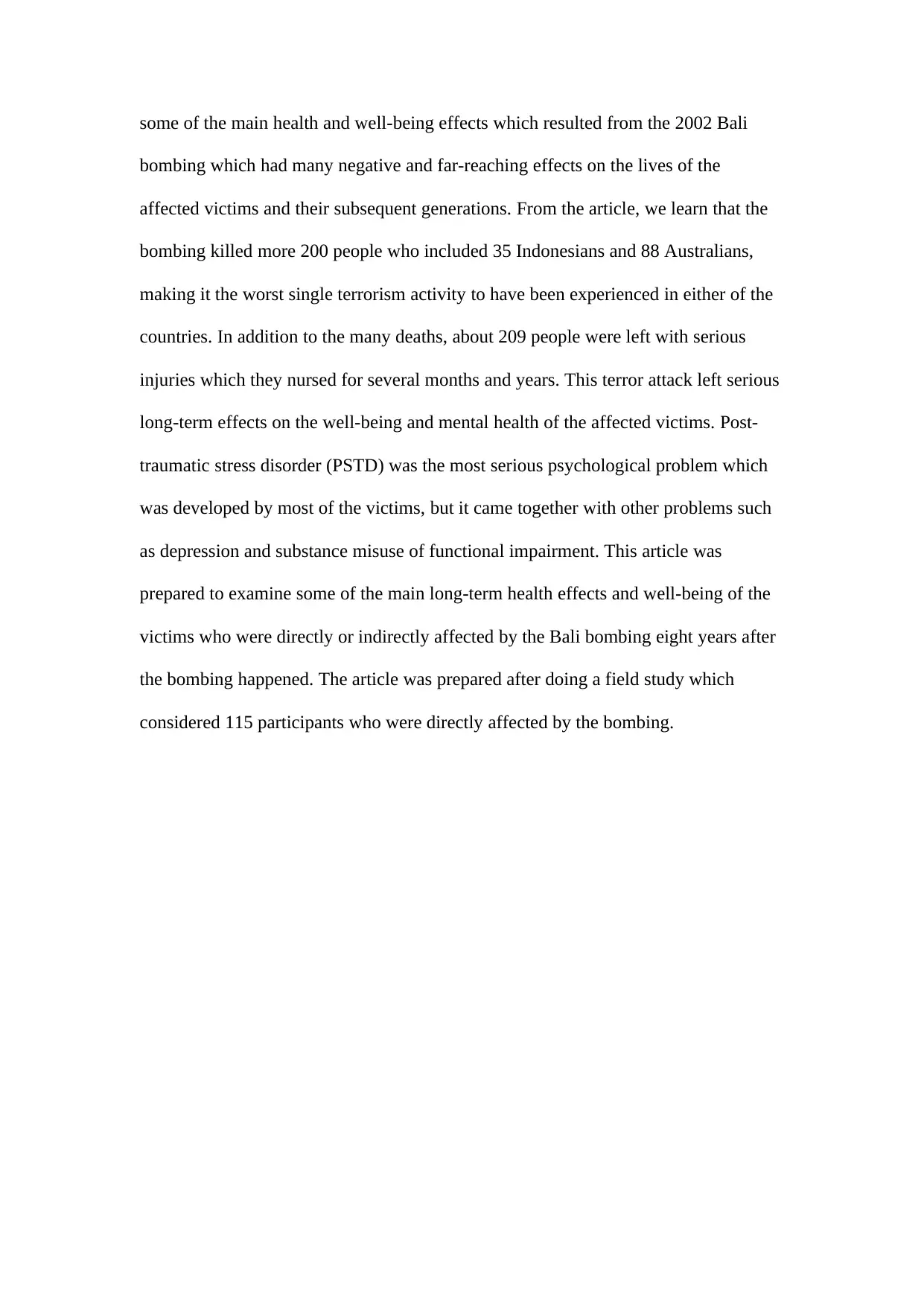
some of the main health and well-being effects which resulted from the 2002 Bali
bombing which had many negative and far-reaching effects on the lives of the
affected victims and their subsequent generations. From the article, we learn that the
bombing killed more 200 people who included 35 Indonesians and 88 Australians,
making it the worst single terrorism activity to have been experienced in either of the
countries. In addition to the many deaths, about 209 people were left with serious
injuries which they nursed for several months and years. This terror attack left serious
long-term effects on the well-being and mental health of the affected victims. Post-
traumatic stress disorder (PSTD) was the most serious psychological problem which
was developed by most of the victims, but it came together with other problems such
as depression and substance misuse of functional impairment. This article was
prepared to examine some of the main long-term health effects and well-being of the
victims who were directly or indirectly affected by the Bali bombing eight years after
the bombing happened. The article was prepared after doing a field study which
considered 115 participants who were directly affected by the bombing.
bombing which had many negative and far-reaching effects on the lives of the
affected victims and their subsequent generations. From the article, we learn that the
bombing killed more 200 people who included 35 Indonesians and 88 Australians,
making it the worst single terrorism activity to have been experienced in either of the
countries. In addition to the many deaths, about 209 people were left with serious
injuries which they nursed for several months and years. This terror attack left serious
long-term effects on the well-being and mental health of the affected victims. Post-
traumatic stress disorder (PSTD) was the most serious psychological problem which
was developed by most of the victims, but it came together with other problems such
as depression and substance misuse of functional impairment. This article was
prepared to examine some of the main long-term health effects and well-being of the
victims who were directly or indirectly affected by the Bali bombing eight years after
the bombing happened. The article was prepared after doing a field study which
considered 115 participants who were directly affected by the bombing.
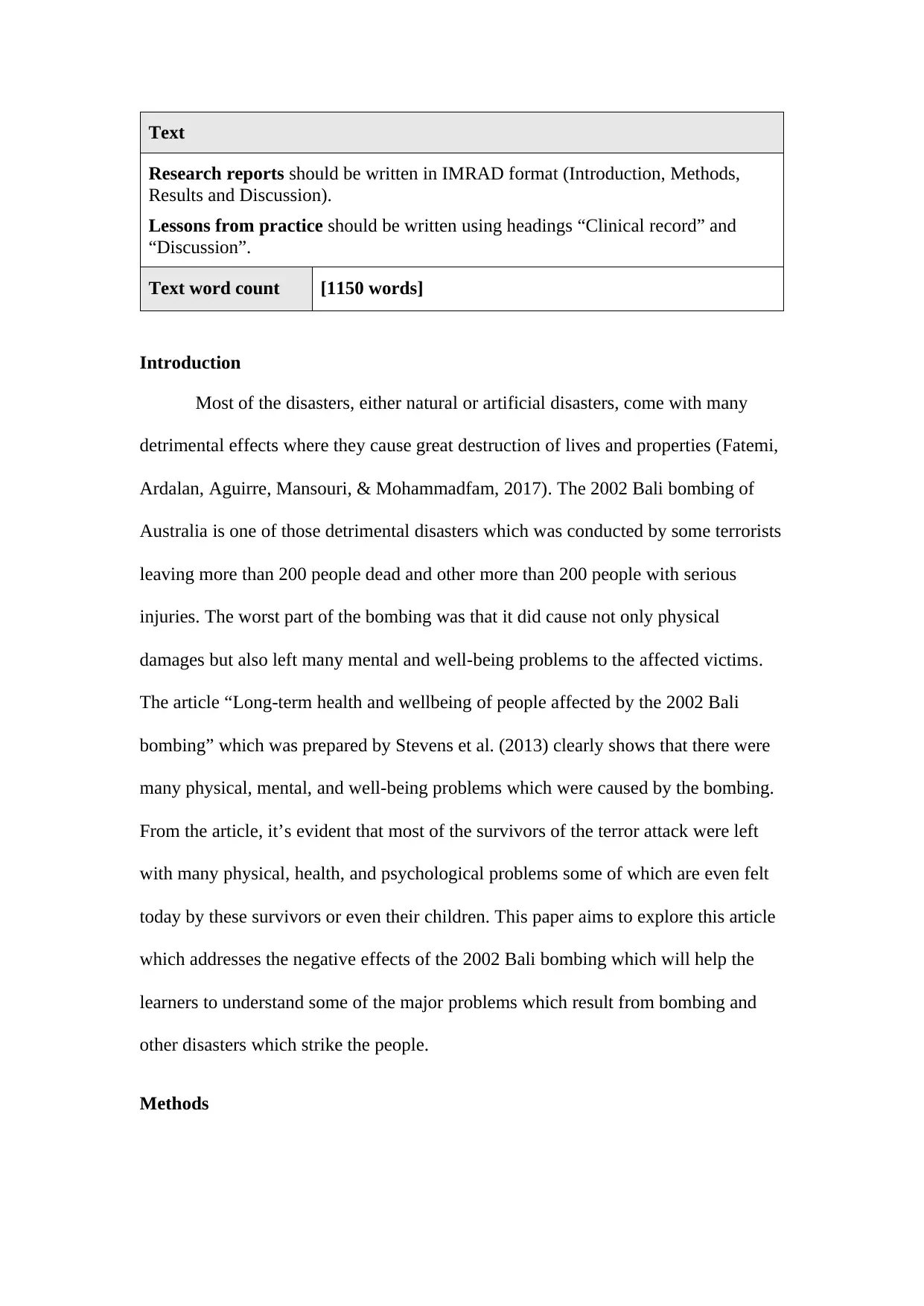
Text
Research reports should be written in IMRAD format (Introduction, Methods,
Results and Discussion).
Lessons from practice should be written using headings “Clinical record” and
“Discussion”.
Text word count [1150 words]
Introduction
Most of the disasters, either natural or artificial disasters, come with many
detrimental effects where they cause great destruction of lives and properties (Fatemi,
Ardalan, Aguirre, Mansouri, & Mohammadfam, 2017). The 2002 Bali bombing of
Australia is one of those detrimental disasters which was conducted by some terrorists
leaving more than 200 people dead and other more than 200 people with serious
injuries. The worst part of the bombing was that it did cause not only physical
damages but also left many mental and well-being problems to the affected victims.
The article “Long-term health and wellbeing of people affected by the 2002 Bali
bombing” which was prepared by Stevens et al. (2013) clearly shows that there were
many physical, mental, and well-being problems which were caused by the bombing.
From the article, it’s evident that most of the survivors of the terror attack were left
with many physical, health, and psychological problems some of which are even felt
today by these survivors or even their children. This paper aims to explore this article
which addresses the negative effects of the 2002 Bali bombing which will help the
learners to understand some of the major problems which result from bombing and
other disasters which strike the people.
Methods
Research reports should be written in IMRAD format (Introduction, Methods,
Results and Discussion).
Lessons from practice should be written using headings “Clinical record” and
“Discussion”.
Text word count [1150 words]
Introduction
Most of the disasters, either natural or artificial disasters, come with many
detrimental effects where they cause great destruction of lives and properties (Fatemi,
Ardalan, Aguirre, Mansouri, & Mohammadfam, 2017). The 2002 Bali bombing of
Australia is one of those detrimental disasters which was conducted by some terrorists
leaving more than 200 people dead and other more than 200 people with serious
injuries. The worst part of the bombing was that it did cause not only physical
damages but also left many mental and well-being problems to the affected victims.
The article “Long-term health and wellbeing of people affected by the 2002 Bali
bombing” which was prepared by Stevens et al. (2013) clearly shows that there were
many physical, mental, and well-being problems which were caused by the bombing.
From the article, it’s evident that most of the survivors of the terror attack were left
with many physical, health, and psychological problems some of which are even felt
today by these survivors or even their children. This paper aims to explore this article
which addresses the negative effects of the 2002 Bali bombing which will help the
learners to understand some of the major problems which result from bombing and
other disasters which strike the people.
Methods
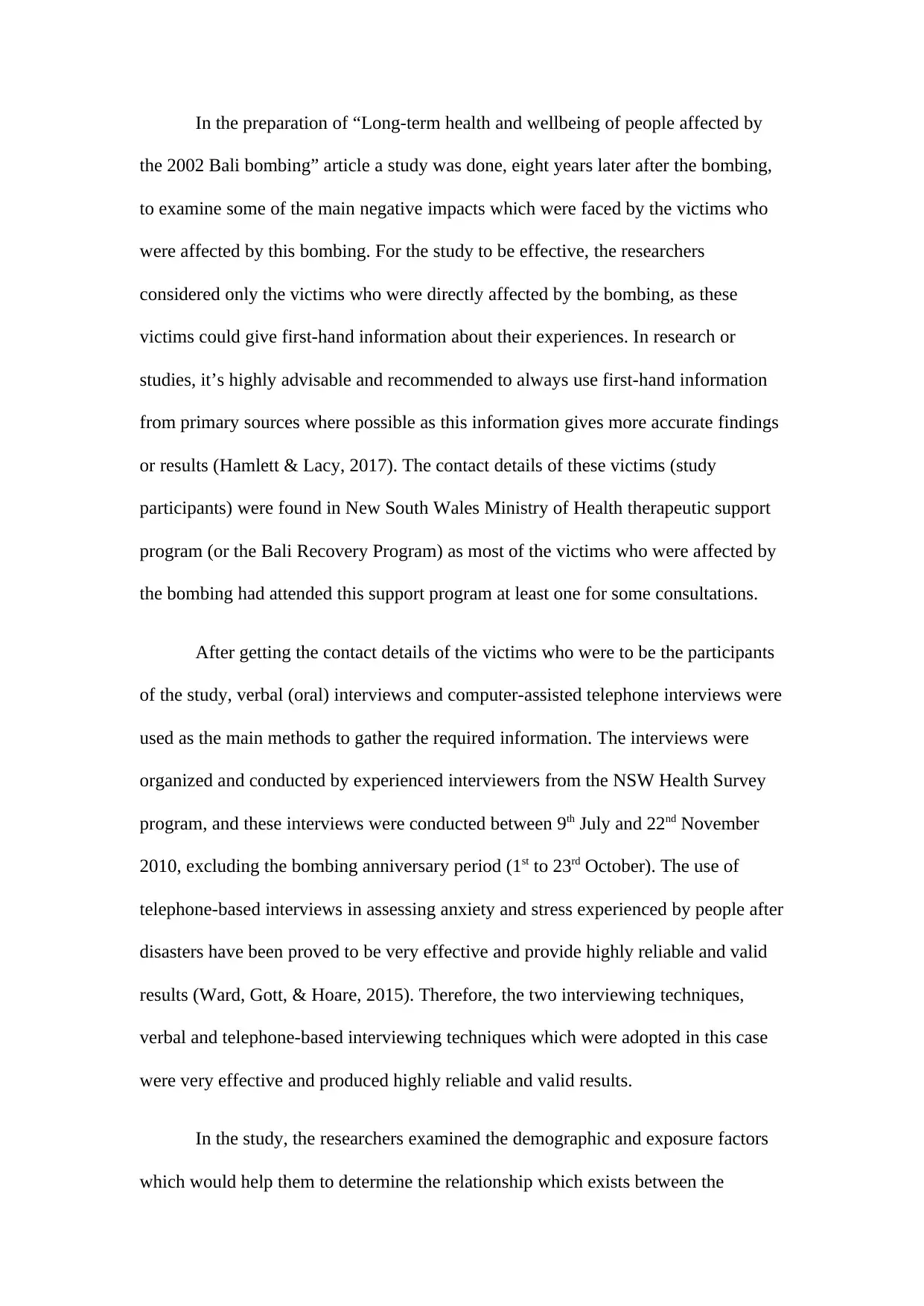
In the preparation of “Long-term health and wellbeing of people affected by
the 2002 Bali bombing” article a study was done, eight years later after the bombing,
to examine some of the main negative impacts which were faced by the victims who
were affected by this bombing. For the study to be effective, the researchers
considered only the victims who were directly affected by the bombing, as these
victims could give first-hand information about their experiences. In research or
studies, it’s highly advisable and recommended to always use first-hand information
from primary sources where possible as this information gives more accurate findings
or results (Hamlett & Lacy, 2017). The contact details of these victims (study
participants) were found in New South Wales Ministry of Health therapeutic support
program (or the Bali Recovery Program) as most of the victims who were affected by
the bombing had attended this support program at least one for some consultations.
After getting the contact details of the victims who were to be the participants
of the study, verbal (oral) interviews and computer-assisted telephone interviews were
used as the main methods to gather the required information. The interviews were
organized and conducted by experienced interviewers from the NSW Health Survey
program, and these interviews were conducted between 9th July and 22nd November
2010, excluding the bombing anniversary period (1st to 23rd October). The use of
telephone-based interviews in assessing anxiety and stress experienced by people after
disasters have been proved to be very effective and provide highly reliable and valid
results (Ward, Gott, & Hoare, 2015). Therefore, the two interviewing techniques,
verbal and telephone-based interviewing techniques which were adopted in this case
were very effective and produced highly reliable and valid results.
In the study, the researchers examined the demographic and exposure factors
which would help them to determine the relationship which exists between the
the 2002 Bali bombing” article a study was done, eight years later after the bombing,
to examine some of the main negative impacts which were faced by the victims who
were affected by this bombing. For the study to be effective, the researchers
considered only the victims who were directly affected by the bombing, as these
victims could give first-hand information about their experiences. In research or
studies, it’s highly advisable and recommended to always use first-hand information
from primary sources where possible as this information gives more accurate findings
or results (Hamlett & Lacy, 2017). The contact details of these victims (study
participants) were found in New South Wales Ministry of Health therapeutic support
program (or the Bali Recovery Program) as most of the victims who were affected by
the bombing had attended this support program at least one for some consultations.
After getting the contact details of the victims who were to be the participants
of the study, verbal (oral) interviews and computer-assisted telephone interviews were
used as the main methods to gather the required information. The interviews were
organized and conducted by experienced interviewers from the NSW Health Survey
program, and these interviews were conducted between 9th July and 22nd November
2010, excluding the bombing anniversary period (1st to 23rd October). The use of
telephone-based interviews in assessing anxiety and stress experienced by people after
disasters have been proved to be very effective and provide highly reliable and valid
results (Ward, Gott, & Hoare, 2015). Therefore, the two interviewing techniques,
verbal and telephone-based interviewing techniques which were adopted in this case
were very effective and produced highly reliable and valid results.
In the study, the researchers examined the demographic and exposure factors
which would help them to determine the relationship which exists between the
Secure Best Marks with AI Grader
Need help grading? Try our AI Grader for instant feedback on your assignments.
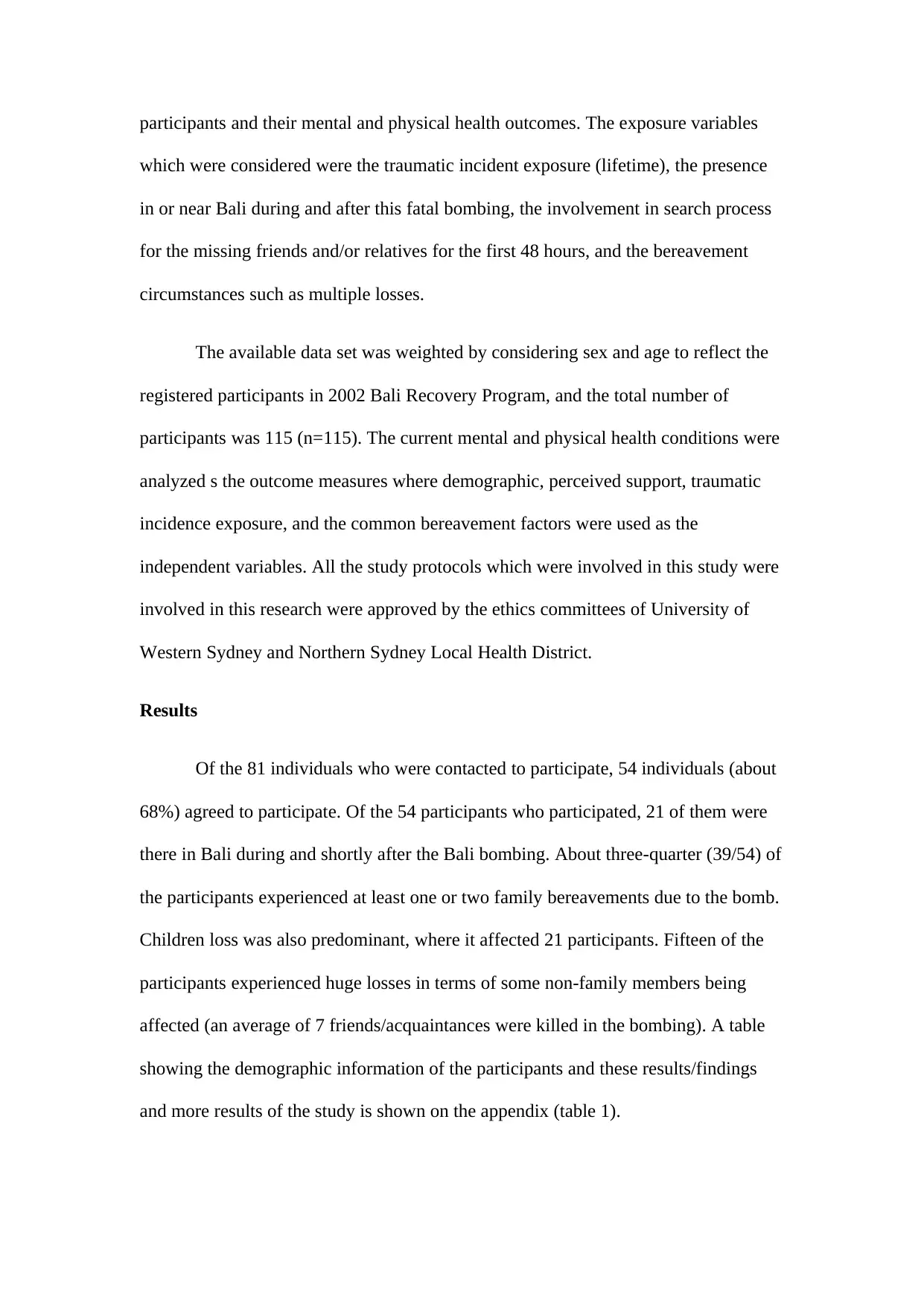
participants and their mental and physical health outcomes. The exposure variables
which were considered were the traumatic incident exposure (lifetime), the presence
in or near Bali during and after this fatal bombing, the involvement in search process
for the missing friends and/or relatives for the first 48 hours, and the bereavement
circumstances such as multiple losses.
The available data set was weighted by considering sex and age to reflect the
registered participants in 2002 Bali Recovery Program, and the total number of
participants was 115 (n=115). The current mental and physical health conditions were
analyzed s the outcome measures where demographic, perceived support, traumatic
incidence exposure, and the common bereavement factors were used as the
independent variables. All the study protocols which were involved in this study were
involved in this research were approved by the ethics committees of University of
Western Sydney and Northern Sydney Local Health District.
Results
Of the 81 individuals who were contacted to participate, 54 individuals (about
68%) agreed to participate. Of the 54 participants who participated, 21 of them were
there in Bali during and shortly after the Bali bombing. About three-quarter (39/54) of
the participants experienced at least one or two family bereavements due to the bomb.
Children loss was also predominant, where it affected 21 participants. Fifteen of the
participants experienced huge losses in terms of some non-family members being
affected (an average of 7 friends/acquaintances were killed in the bombing). A table
showing the demographic information of the participants and these results/findings
and more results of the study is shown on the appendix (table 1).
which were considered were the traumatic incident exposure (lifetime), the presence
in or near Bali during and after this fatal bombing, the involvement in search process
for the missing friends and/or relatives for the first 48 hours, and the bereavement
circumstances such as multiple losses.
The available data set was weighted by considering sex and age to reflect the
registered participants in 2002 Bali Recovery Program, and the total number of
participants was 115 (n=115). The current mental and physical health conditions were
analyzed s the outcome measures where demographic, perceived support, traumatic
incidence exposure, and the common bereavement factors were used as the
independent variables. All the study protocols which were involved in this study were
involved in this research were approved by the ethics committees of University of
Western Sydney and Northern Sydney Local Health District.
Results
Of the 81 individuals who were contacted to participate, 54 individuals (about
68%) agreed to participate. Of the 54 participants who participated, 21 of them were
there in Bali during and shortly after the Bali bombing. About three-quarter (39/54) of
the participants experienced at least one or two family bereavements due to the bomb.
Children loss was also predominant, where it affected 21 participants. Fifteen of the
participants experienced huge losses in terms of some non-family members being
affected (an average of 7 friends/acquaintances were killed in the bombing). A table
showing the demographic information of the participants and these results/findings
and more results of the study is shown on the appendix (table 1).
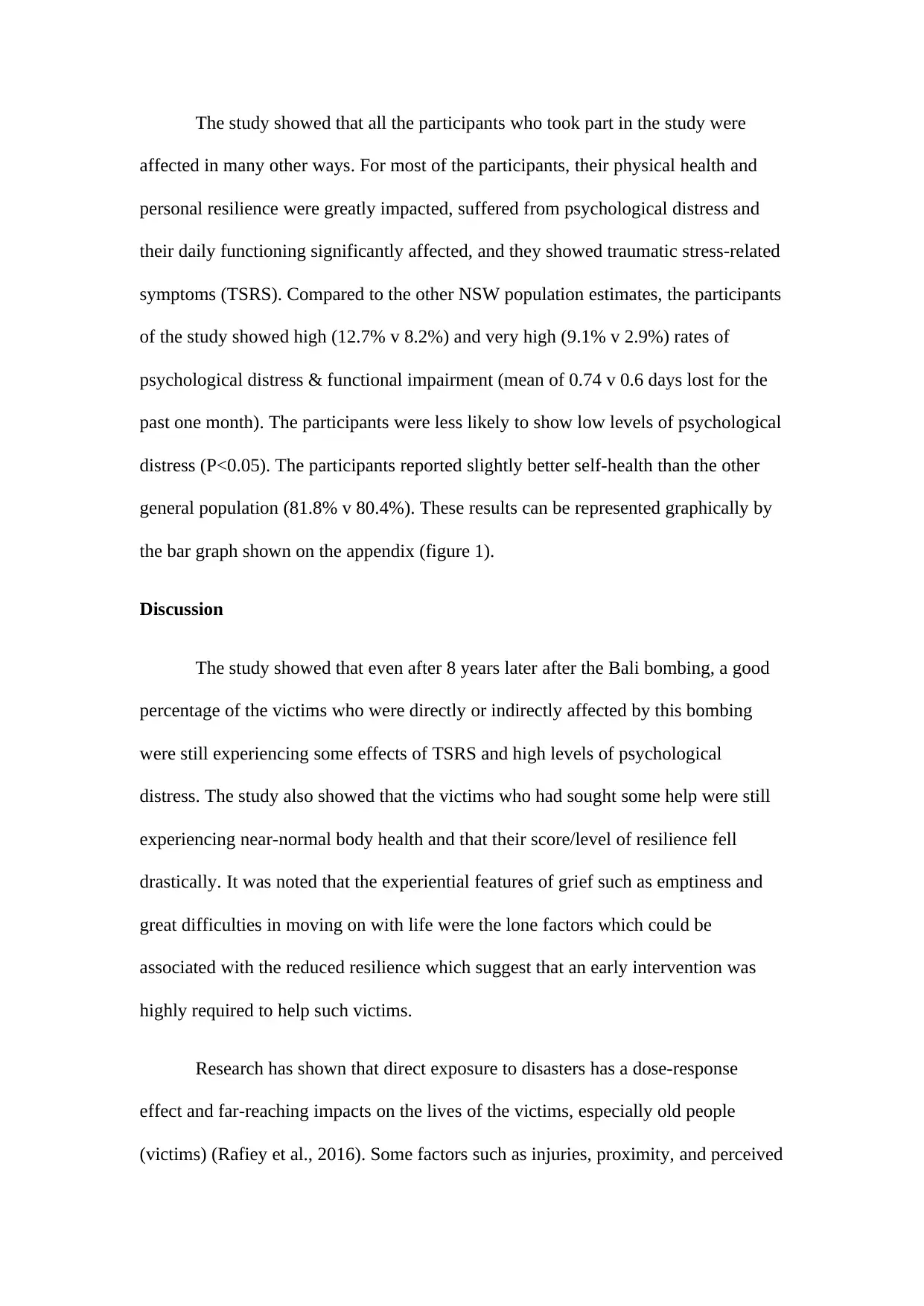
The study showed that all the participants who took part in the study were
affected in many other ways. For most of the participants, their physical health and
personal resilience were greatly impacted, suffered from psychological distress and
their daily functioning significantly affected, and they showed traumatic stress-related
symptoms (TSRS). Compared to the other NSW population estimates, the participants
of the study showed high (12.7% v 8.2%) and very high (9.1% v 2.9%) rates of
psychological distress & functional impairment (mean of 0.74 v 0.6 days lost for the
past one month). The participants were less likely to show low levels of psychological
distress (P<0.05). The participants reported slightly better self-health than the other
general population (81.8% v 80.4%). These results can be represented graphically by
the bar graph shown on the appendix (figure 1).
Discussion
The study showed that even after 8 years later after the Bali bombing, a good
percentage of the victims who were directly or indirectly affected by this bombing
were still experiencing some effects of TSRS and high levels of psychological
distress. The study also showed that the victims who had sought some help were still
experiencing near-normal body health and that their score/level of resilience fell
drastically. It was noted that the experiential features of grief such as emptiness and
great difficulties in moving on with life were the lone factors which could be
associated with the reduced resilience which suggest that an early intervention was
highly required to help such victims.
Research has shown that direct exposure to disasters has a dose-response
effect and far-reaching impacts on the lives of the victims, especially old people
(victims) (Rafiey et al., 2016). Some factors such as injuries, proximity, and perceived
affected in many other ways. For most of the participants, their physical health and
personal resilience were greatly impacted, suffered from psychological distress and
their daily functioning significantly affected, and they showed traumatic stress-related
symptoms (TSRS). Compared to the other NSW population estimates, the participants
of the study showed high (12.7% v 8.2%) and very high (9.1% v 2.9%) rates of
psychological distress & functional impairment (mean of 0.74 v 0.6 days lost for the
past one month). The participants were less likely to show low levels of psychological
distress (P<0.05). The participants reported slightly better self-health than the other
general population (81.8% v 80.4%). These results can be represented graphically by
the bar graph shown on the appendix (figure 1).
Discussion
The study showed that even after 8 years later after the Bali bombing, a good
percentage of the victims who were directly or indirectly affected by this bombing
were still experiencing some effects of TSRS and high levels of psychological
distress. The study also showed that the victims who had sought some help were still
experiencing near-normal body health and that their score/level of resilience fell
drastically. It was noted that the experiential features of grief such as emptiness and
great difficulties in moving on with life were the lone factors which could be
associated with the reduced resilience which suggest that an early intervention was
highly required to help such victims.
Research has shown that direct exposure to disasters has a dose-response
effect and far-reaching impacts on the lives of the victims, especially old people
(victims) (Rafiey et al., 2016). Some factors such as injuries, proximity, and perceived
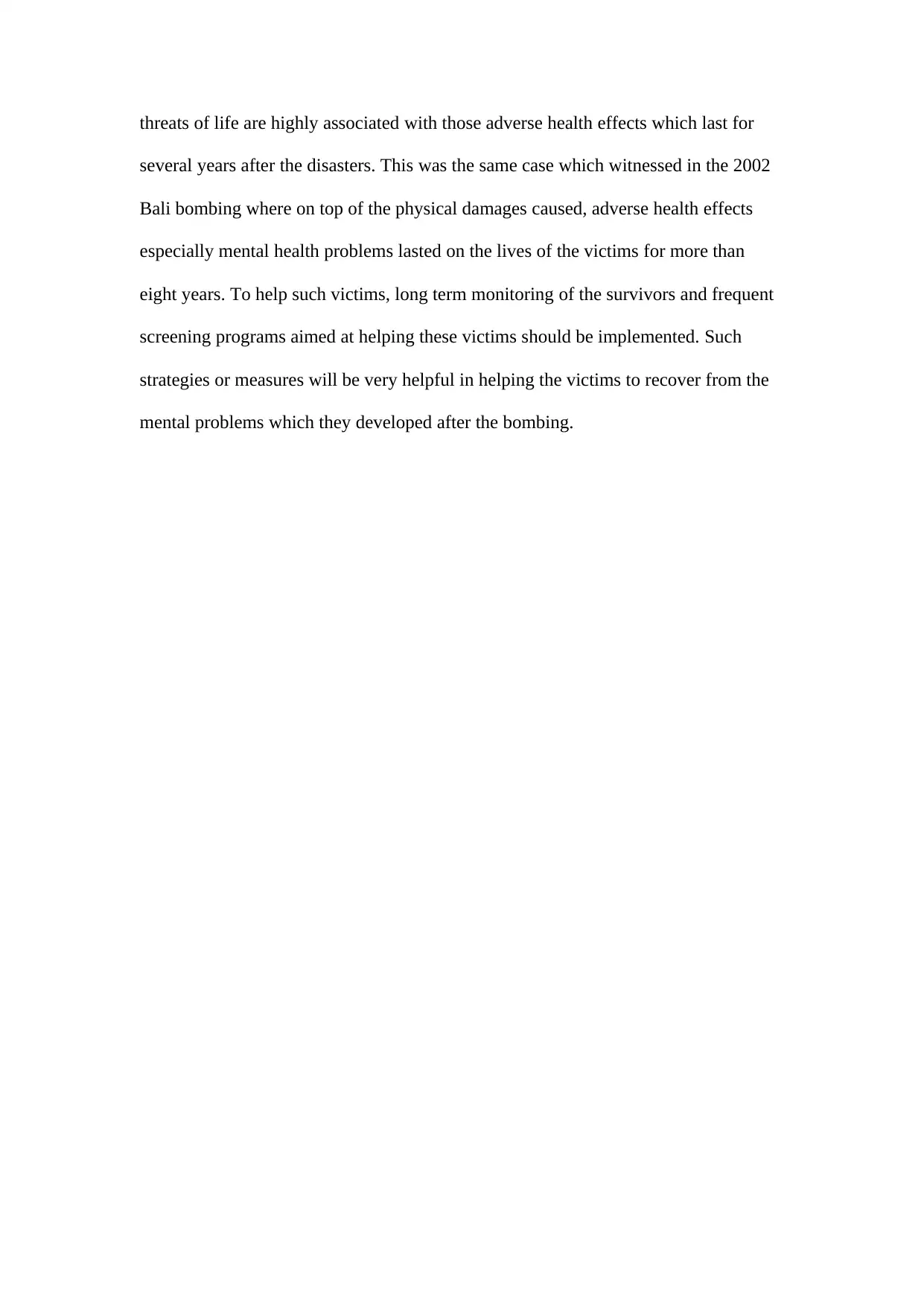
threats of life are highly associated with those adverse health effects which last for
several years after the disasters. This was the same case which witnessed in the 2002
Bali bombing where on top of the physical damages caused, adverse health effects
especially mental health problems lasted on the lives of the victims for more than
eight years. To help such victims, long term monitoring of the survivors and frequent
screening programs aimed at helping these victims should be implemented. Such
strategies or measures will be very helpful in helping the victims to recover from the
mental problems which they developed after the bombing.
several years after the disasters. This was the same case which witnessed in the 2002
Bali bombing where on top of the physical damages caused, adverse health effects
especially mental health problems lasted on the lives of the victims for more than
eight years. To help such victims, long term monitoring of the survivors and frequent
screening programs aimed at helping these victims should be implemented. Such
strategies or measures will be very helpful in helping the victims to recover from the
mental problems which they developed after the bombing.
Paraphrase This Document
Need a fresh take? Get an instant paraphrase of this document with our AI Paraphraser
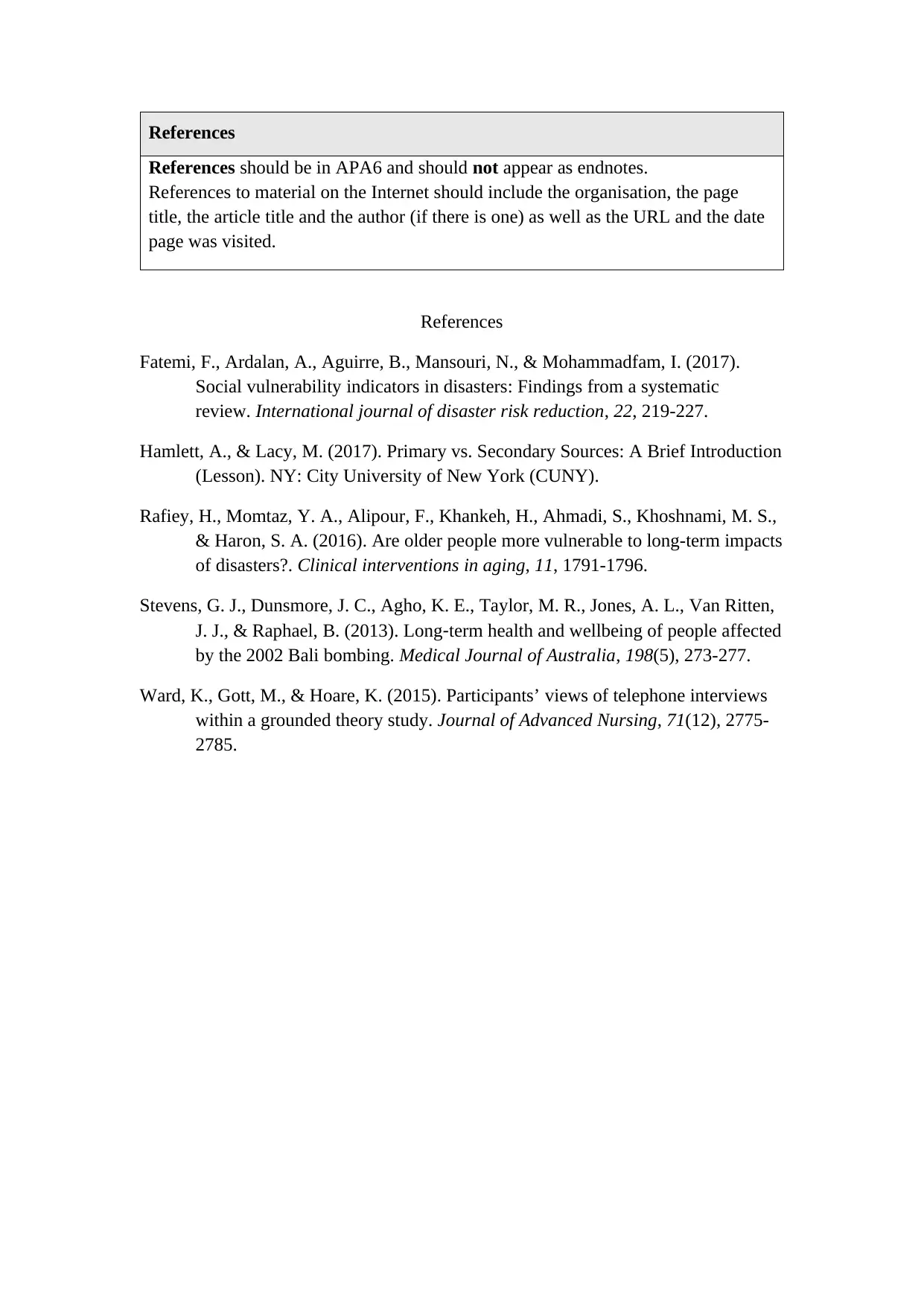
References
References should be in APA6 and should not appear as endnotes.
References to material on the Internet should include the organisation, the page
title, the article title and the author (if there is one) as well as the URL and the date
page was visited.
References
Fatemi, F., Ardalan, A., Aguirre, B., Mansouri, N., & Mohammadfam, I. (2017).
Social vulnerability indicators in disasters: Findings from a systematic
review. International journal of disaster risk reduction, 22, 219-227.
Hamlett, A., & Lacy, M. (2017). Primary vs. Secondary Sources: A Brief Introduction
(Lesson). NY: City University of New York (CUNY).
Rafiey, H., Momtaz, Y. A., Alipour, F., Khankeh, H., Ahmadi, S., Khoshnami, M. S.,
& Haron, S. A. (2016). Are older people more vulnerable to long-term impacts
of disasters?. Clinical interventions in aging, 11, 1791-1796.
Stevens, G. J., Dunsmore, J. C., Agho, K. E., Taylor, M. R., Jones, A. L., Van Ritten,
J. J., & Raphael, B. (2013). Long‐term health and wellbeing of people affected
by the 2002 Bali bombing. Medical Journal of Australia, 198(5), 273-277.
Ward, K., Gott, M., & Hoare, K. (2015). Participants’ views of telephone interviews
within a grounded theory study. Journal of Advanced Nursing, 71(12), 2775-
2785.
References should be in APA6 and should not appear as endnotes.
References to material on the Internet should include the organisation, the page
title, the article title and the author (if there is one) as well as the URL and the date
page was visited.
References
Fatemi, F., Ardalan, A., Aguirre, B., Mansouri, N., & Mohammadfam, I. (2017).
Social vulnerability indicators in disasters: Findings from a systematic
review. International journal of disaster risk reduction, 22, 219-227.
Hamlett, A., & Lacy, M. (2017). Primary vs. Secondary Sources: A Brief Introduction
(Lesson). NY: City University of New York (CUNY).
Rafiey, H., Momtaz, Y. A., Alipour, F., Khankeh, H., Ahmadi, S., Khoshnami, M. S.,
& Haron, S. A. (2016). Are older people more vulnerable to long-term impacts
of disasters?. Clinical interventions in aging, 11, 1791-1796.
Stevens, G. J., Dunsmore, J. C., Agho, K. E., Taylor, M. R., Jones, A. L., Van Ritten,
J. J., & Raphael, B. (2013). Long‐term health and wellbeing of people affected
by the 2002 Bali bombing. Medical Journal of Australia, 198(5), 273-277.
Ward, K., Gott, M., & Hoare, K. (2015). Participants’ views of telephone interviews
within a grounded theory study. Journal of Advanced Nursing, 71(12), 2775-
2785.
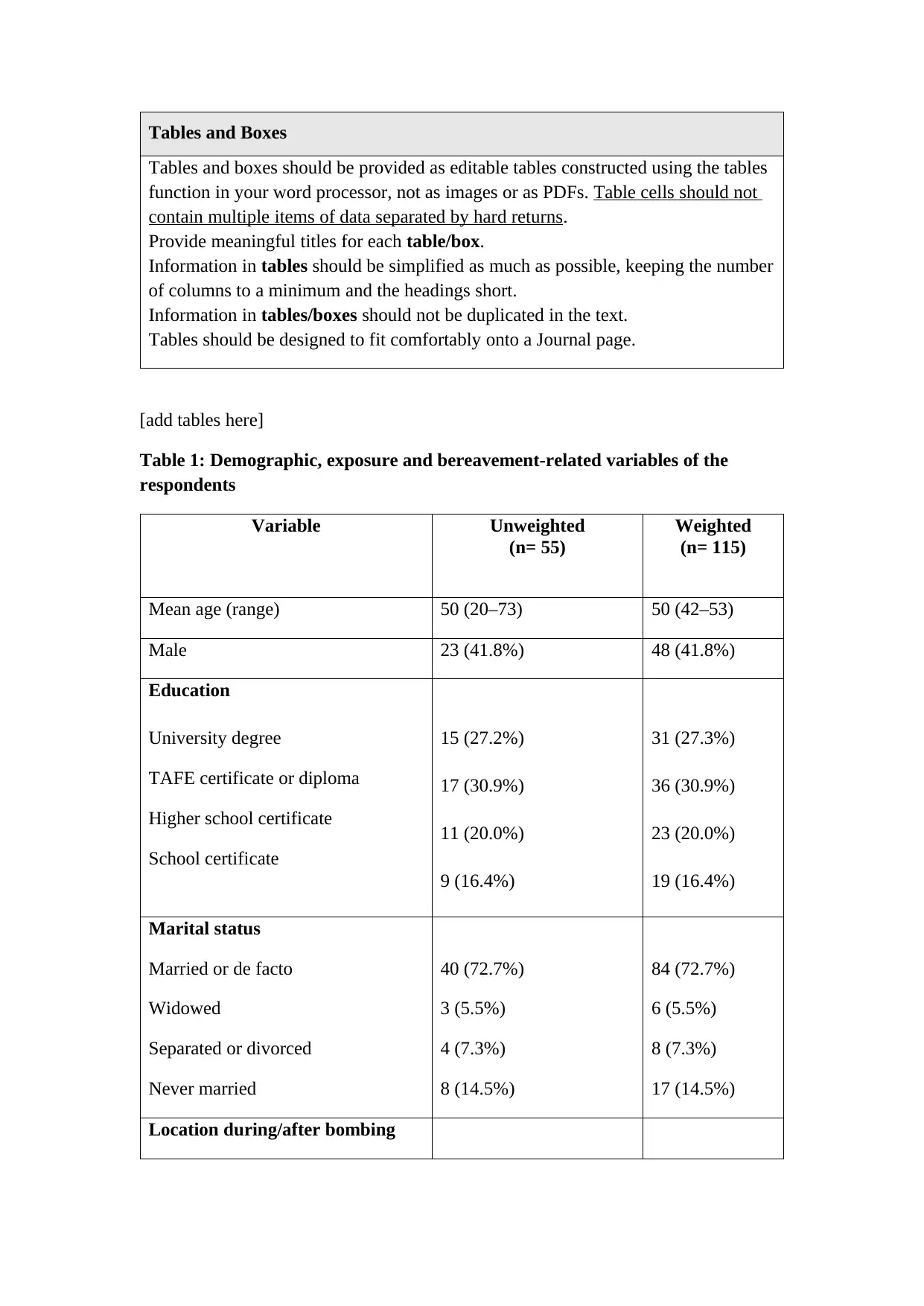
Tables and Boxes
Tables and boxes should be provided as editable tables constructed using the tables
function in your word processor, not as images or as PDFs. Table cells should not
contain multiple items of data separated by hard returns.
Provide meaningful titles for each table/box.
Information in tables should be simplified as much as possible, keeping the number
of columns to a minimum and the headings short.
Information in tables/boxes should not be duplicated in the text.
Tables should be designed to fit comfortably onto a Journal page.
[add tables here]
Table 1: Demographic, exposure and bereavement-related variables of the
respondents
Variable Unweighted
(n= 55)
Weighted
(n= 115)
Mean age (range) 50 (20–73) 50 (42–53)
Male 23 (41.8%) 48 (41.8%)
Education
University degree
TAFE certificate or diploma
Higher school certificate
School certificate
15 (27.2%)
17 (30.9%)
11 (20.0%)
9 (16.4%)
31 (27.3%)
36 (30.9%)
23 (20.0%)
19 (16.4%)
Marital status
Married or de facto
Widowed
Separated or divorced
Never married
40 (72.7%)
3 (5.5%)
4 (7.3%)
8 (14.5%)
84 (72.7%)
6 (5.5%)
8 (7.3%)
17 (14.5%)
Location during/after bombing
Tables and boxes should be provided as editable tables constructed using the tables
function in your word processor, not as images or as PDFs. Table cells should not
contain multiple items of data separated by hard returns.
Provide meaningful titles for each table/box.
Information in tables should be simplified as much as possible, keeping the number
of columns to a minimum and the headings short.
Information in tables/boxes should not be duplicated in the text.
Tables should be designed to fit comfortably onto a Journal page.
[add tables here]
Table 1: Demographic, exposure and bereavement-related variables of the
respondents
Variable Unweighted
(n= 55)
Weighted
(n= 115)
Mean age (range) 50 (20–73) 50 (42–53)
Male 23 (41.8%) 48 (41.8%)
Education
University degree
TAFE certificate or diploma
Higher school certificate
School certificate
15 (27.2%)
17 (30.9%)
11 (20.0%)
9 (16.4%)
31 (27.3%)
36 (30.9%)
23 (20.0%)
19 (16.4%)
Marital status
Married or de facto
Widowed
Separated or divorced
Never married
40 (72.7%)
3 (5.5%)
4 (7.3%)
8 (14.5%)
84 (72.7%)
6 (5.5%)
8 (7.3%)
17 (14.5%)
Location during/after bombing
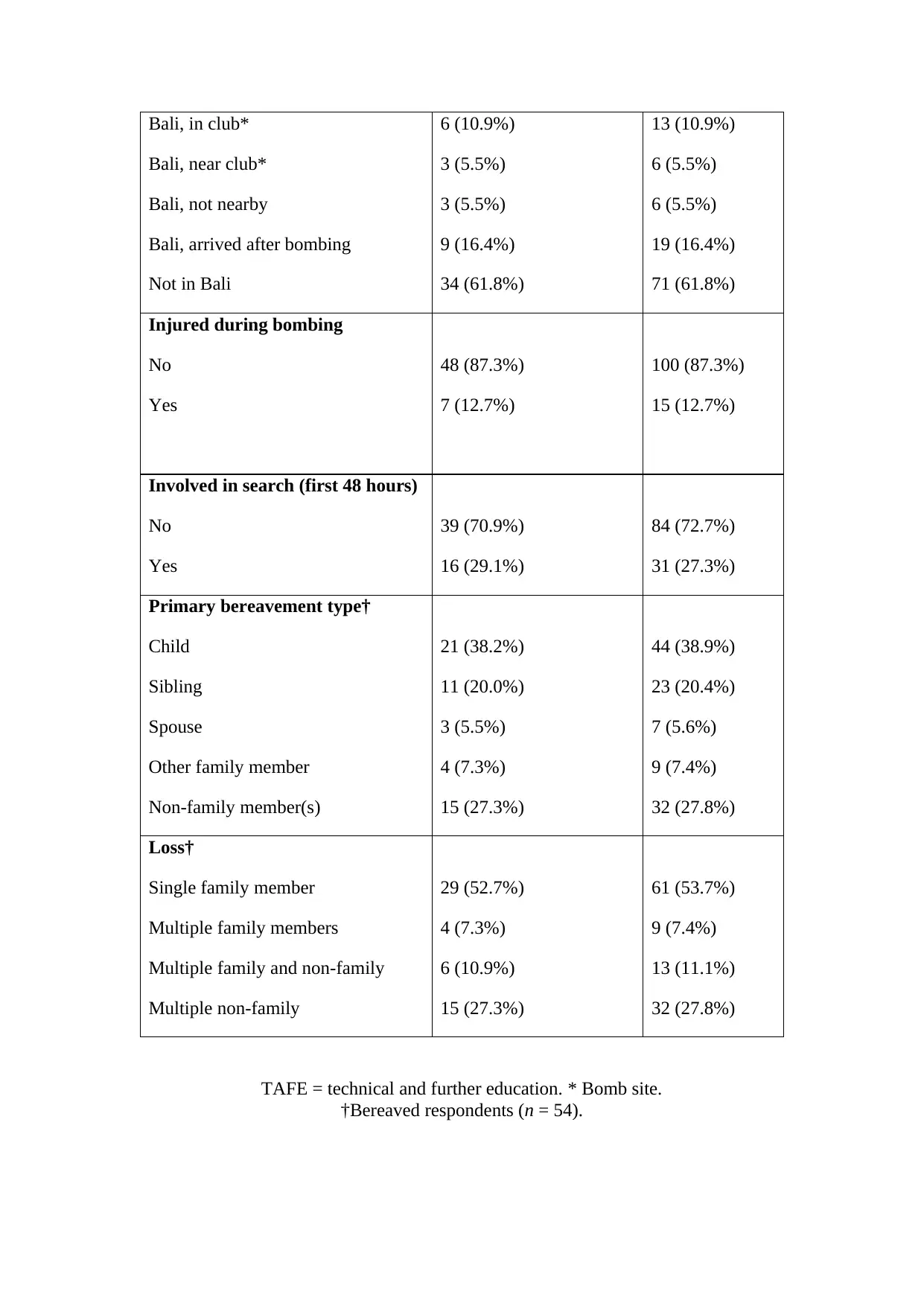
Bali, in club*
Bali, near club*
Bali, not nearby
Bali, arrived after bombing
Not in Bali
6 (10.9%)
3 (5.5%)
3 (5.5%)
9 (16.4%)
34 (61.8%)
13 (10.9%)
6 (5.5%)
6 (5.5%)
19 (16.4%)
71 (61.8%)
Injured during bombing
No
Yes
48 (87.3%)
7 (12.7%)
100 (87.3%)
15 (12.7%)
Involved in search (first 48 hours)
No
Yes
39 (70.9%)
16 (29.1%)
84 (72.7%)
31 (27.3%)
Primary bereavement type†
Child
Sibling
Spouse
Other family member
Non-family member(s)
21 (38.2%)
11 (20.0%)
3 (5.5%)
4 (7.3%)
15 (27.3%)
44 (38.9%)
23 (20.4%)
7 (5.6%)
9 (7.4%)
32 (27.8%)
Loss†
Single family member
Multiple family members
Multiple family and non-family
Multiple non-family
29 (52.7%)
4 (7.3%)
6 (10.9%)
15 (27.3%)
61 (53.7%)
9 (7.4%)
13 (11.1%)
32 (27.8%)
TAFE = technical and further education. * Bomb site.
†Bereaved respondents (n = 54).
Bali, near club*
Bali, not nearby
Bali, arrived after bombing
Not in Bali
6 (10.9%)
3 (5.5%)
3 (5.5%)
9 (16.4%)
34 (61.8%)
13 (10.9%)
6 (5.5%)
6 (5.5%)
19 (16.4%)
71 (61.8%)
Injured during bombing
No
Yes
48 (87.3%)
7 (12.7%)
100 (87.3%)
15 (12.7%)
Involved in search (first 48 hours)
No
Yes
39 (70.9%)
16 (29.1%)
84 (72.7%)
31 (27.3%)
Primary bereavement type†
Child
Sibling
Spouse
Other family member
Non-family member(s)
21 (38.2%)
11 (20.0%)
3 (5.5%)
4 (7.3%)
15 (27.3%)
44 (38.9%)
23 (20.4%)
7 (5.6%)
9 (7.4%)
32 (27.8%)
Loss†
Single family member
Multiple family members
Multiple family and non-family
Multiple non-family
29 (52.7%)
4 (7.3%)
6 (10.9%)
15 (27.3%)
61 (53.7%)
9 (7.4%)
13 (11.1%)
32 (27.8%)
TAFE = technical and further education. * Bomb site.
†Bereaved respondents (n = 54).
Secure Best Marks with AI Grader
Need help grading? Try our AI Grader for instant feedback on your assignments.
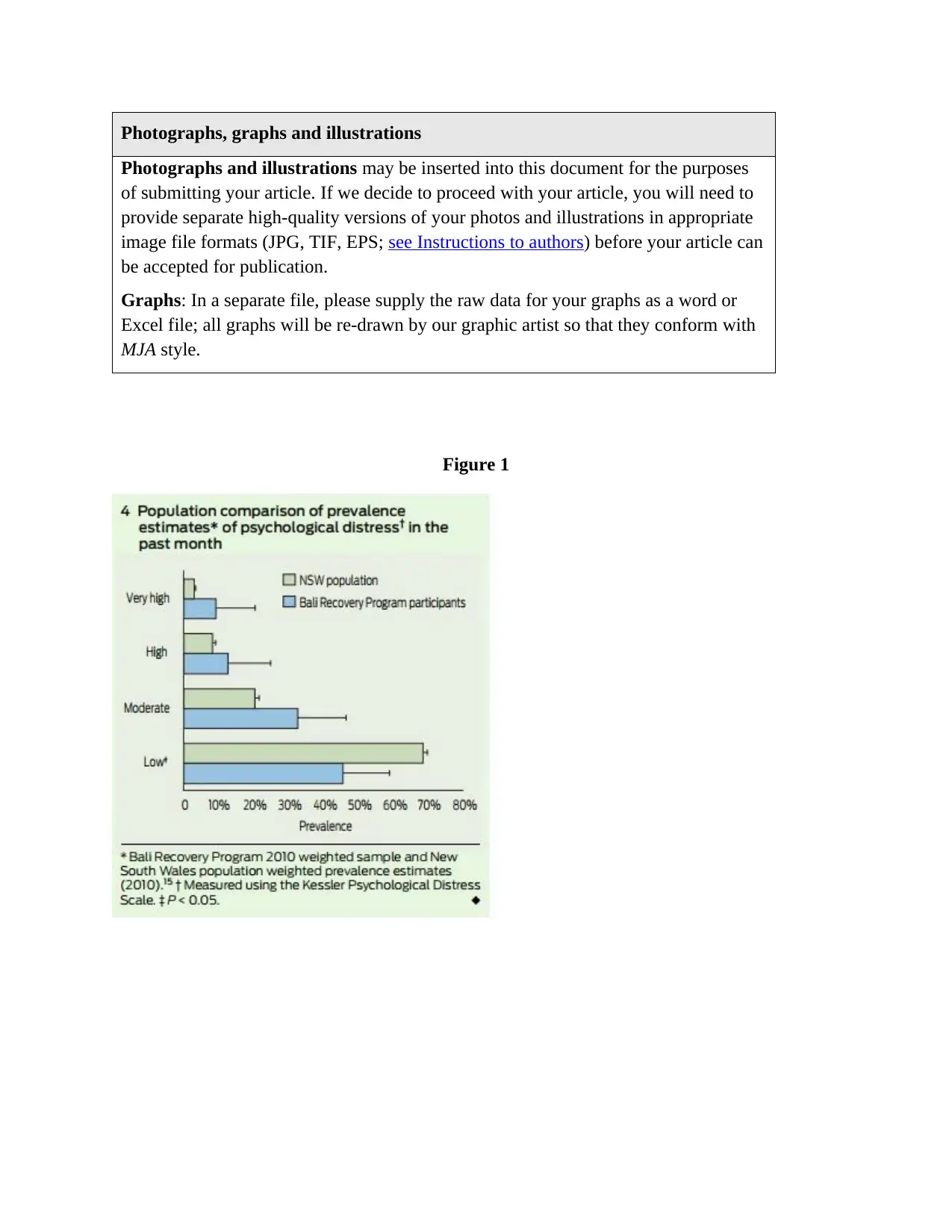
Photographs, graphs and illustrations
Photographs and illustrations may be inserted into this document for the purposes
of submitting your article. If we decide to proceed with your article, you will need to
provide separate high-quality versions of your photos and illustrations in appropriate
image file formats (JPG, TIF, EPS; see Instructions to authors) before your article can
be accepted for publication.
Graphs: In a separate file, please supply the raw data for your graphs as a word or
Excel file; all graphs will be re-drawn by our graphic artist so that they conform with
MJA style.
Figure 1
Photographs and illustrations may be inserted into this document for the purposes
of submitting your article. If we decide to proceed with your article, you will need to
provide separate high-quality versions of your photos and illustrations in appropriate
image file formats (JPG, TIF, EPS; see Instructions to authors) before your article can
be accepted for publication.
Graphs: In a separate file, please supply the raw data for your graphs as a word or
Excel file; all graphs will be re-drawn by our graphic artist so that they conform with
MJA style.
Figure 1
1 out of 11
Your All-in-One AI-Powered Toolkit for Academic Success.
+13062052269
info@desklib.com
Available 24*7 on WhatsApp / Email
![[object Object]](/_next/static/media/star-bottom.7253800d.svg)
Unlock your academic potential
© 2024 | Zucol Services PVT LTD | All rights reserved.